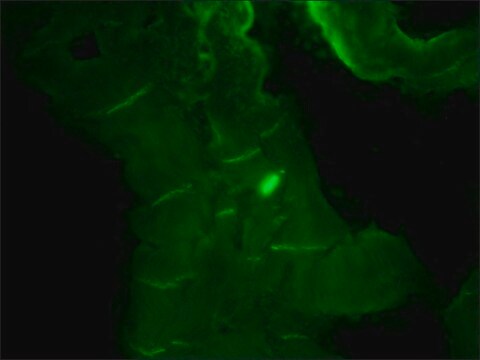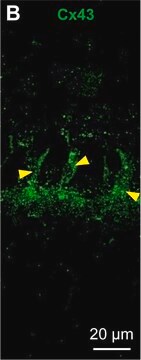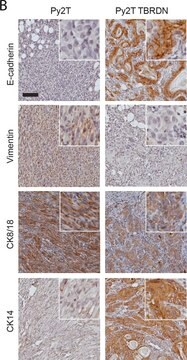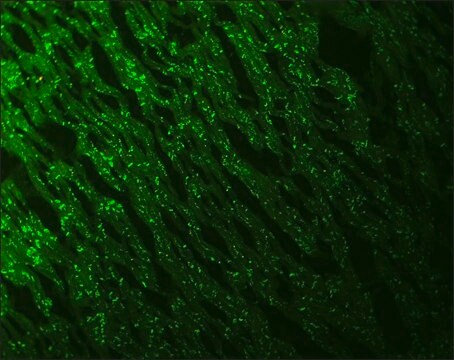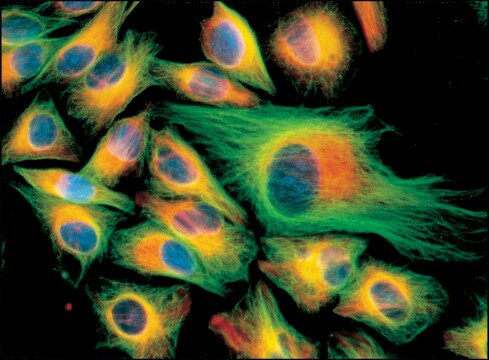C1821
Monoclonal Anti-Pan Cadherin antibody produced in mouse
clone CH-19, ascites fluid
Sinonimo/i:
Monoclonal Anti-Pan Cadherin
About This Item
Prodotti consigliati
Origine biologica
mouse
Livello qualitativo
Coniugato
unconjugated
Forma dell’anticorpo
ascites fluid
Tipo di anticorpo
primary antibodies
Clone
CH-19, monoclonal
PM
antigen 135 kDa
contiene
15 mM sodium azide
Reattività contro le specie
canine, frog, snake, guinea pig, chicken, pig, feline, bovine, rabbit, hamster, Psammomys (sand rat), goat, rat, human, sheep, mouse
tecniche
immunohistochemistry (formalin-fixed, paraffin-embedded sections): 1:500 using protease-digested animal heart sections
indirect immunofluorescence: 1:500 using cultured MDBK cells
microarray: suitable
western blot: suitable
Isotipo
IgG1
N° accesso UniProt
applicazioni
research pathology
Condizioni di spedizione
dry ice
Temperatura di conservazione
−20°C
modifica post-traduzionali bersaglio
unmodified
Informazioni sul gene
human ... CDH1(999) , CDH2(1000) , CDH3(1001)
mouse ... Cdh1(12550) , Cdh2(12558) , Cdh3(12560)
rat ... Cdh1(83502) , Cdh2(83501) , Cdh3(116777)
Cerchi prodotti simili? Visita Guida al confronto tra prodotti
Descrizione generale
Cadherins that are primarily located in areas of cell-cell contacts are involved in selective cell sorting and in the mechanical cytoplasmic response. They are implicated in morphogenetic processes, intercellular signalling and in tumor invasiveness and metastasis.
Multiple cadherins have been characterized from diverse species and tissues including E-Cadherin, N-Cadherin (A-CAM), P-Cadherin, V-Cadherin, R-Cadherin and T-Cadherin. Specific polyclonal antibodies against a highly conserved sequence from the cytoplasmic C-terminal of N-Cadherin has been prepared.
Specificità
Immunogeno
Applicazioni
- fluorescence imaging
- immunohistochemistry
- western blotting
- immunoblotting
- immunofluorescence
Azioni biochim/fisiol
Esclusione di responsabilità
Non trovi il prodotto giusto?
Prova il nostro Motore di ricerca dei prodotti.
Raccomandato
Codice della classe di stoccaggio
12 - Non Combustible Liquids
Classe di pericolosità dell'acqua (WGK)
nwg
Punto d’infiammabilità (°F)
Not applicable
Punto d’infiammabilità (°C)
Not applicable
Scegli una delle versioni più recenti:
Possiedi già questo prodotto?
I documenti relativi ai prodotti acquistati recentemente sono disponibili nell’Archivio dei documenti.
I clienti hanno visto anche
Il team dei nostri ricercatori vanta grande esperienza in tutte le aree della ricerca quali Life Science, scienza dei materiali, sintesi chimica, cromatografia, discipline analitiche, ecc..
Contatta l'Assistenza Tecnica.